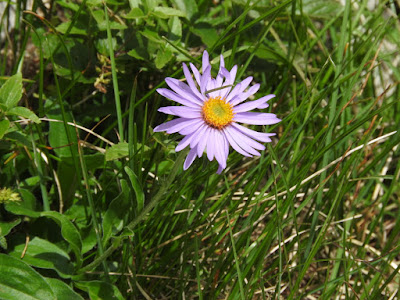Following a severe ice storm a few years ago (that broke and weakened a large amount of trees) most of the conifer forests in western Slovenia are now being hit by bark beetle Ips typographus outbreaks. As I have recently experienced, in the majority of conifer and mixed forests, one can now notice a greater presence of ill and dying Norway spruce. In mountain forests, this event favours the presence of Three-toed and other woodpeckers, because of the food abundancy present on the infected trees. On the other hand, this event is seen as a plague by foresters. I therefore expect that most of the ill trees will be cut down soon and the habitat destroyed, as it is usually done in such cases.
For a better understanding of the bark beetle "problem" I strongly recommend watching these two videos about the current situation in the Bialowieza forest (Poland): Three-toed Woodpecker & Spruce power. Similar situations are also present wherever bark beetle outbreaks occur (in Slovenia too) and is difficult to let people know, that such events are actually part of a natural process and as such they bring positive effects to the forest ecosystem. This interesting article from a study in the Bohemian forest is also well recommended.
More pics about the beetle in this post.
More pics about the beetle in this post.
 |
| Norway spruce Picea abies infected by bark beetles Ips typographus, Trnovski gozd, 29th August 2016. |
 |
| Typical signs (carvings) made by the bark beetle Ips typographus, Trnovski gozd, 29th August 2016. |
So the other day, while visiting an "infected" part of the forest, I was glad to catch up (a bit by coincidence) with a female Three-toed Woodpecker Picoides tridactylus, doing its favourite job - knocking on a dead spruce in search of food. The woodpecker was on a patch of forest where I've never seen the species before, probably because until not long ago, the conifers were still vital. Sharing the feeding space and exploiting the abundance of food were also two Great Spotted Woodpeckers Dendrocopos major (ad and juv) and a Black Woodpecker Dryocopus martius. Not far away I also heard a Grey-headed Woodpecker Picus canus.
 |
| Three-toed Woodpecker Picoides tridactylus (female), Trnovski gozd, 29th August 2016. |
Trnovski gozd is mostly known for its beech stands and the other day I also visited a very nice patch of almost untouched forest. There, on the top of some forested hills, beech trees have also been affected by the ice storm and the signs are still visible several years after the event. Many trees have lost the upper parts/branches and remained almost canopy-less.
 |
| Beech stand affected by the ice storm, Trnovski gozd, 29th August 2016. |
Broken trees and branches create a whole variety of natural cavities that animals can exploit for nesting/roosting. Ural Owl Strix uralensis is a classical example of a bird that for nesting needs large natural cavities in trees. In a nice patch of forest I hooted a Ural Owl call and half a minute later, there it was! It sat there on the same branch for something like 20 minutes.
 |
| Ural Owl Strix uralensis, Trnovski gozd, 29th August 2016. |
The forest is now quite lively with all the juveniles of different species, forming flocks and roving around in groups. Moreover there are lots of migrants around (on their way to Africa), like Pied Flycatchers Ficedula hypoleuca, Wood Warblers Phylloscopus sibilatrix and Willow Warblers Phylloscopus trochilus. Of the residents, the most obvious were: Bullfinch Pyrrhula pyrrhula, Willow Tit Poecile montanus, Coal Tit Periparus ater, Crested Tit Lophophanes cristatus, Treecreeper Certhia familiaris and Nuthatch Sitta europaea.
To round up the trip, an adult Golden Eagle Aquila chrysaetos put on full view, on the cliffs above Ajdovščina, on the way back home. Below is some other forest wildlife, found along the way.
To round up the trip, an adult Golden Eagle Aquila chrysaetos put on full view, on the cliffs above Ajdovščina, on the way back home. Below is some other forest wildlife, found along the way.
 |
| Telekia speciosa, Trnovski gozd, 29th August 2016. |
 |
| Peacock Butterfly Inachis io on Telekia speciosa, Trnovski gozd, 29th August 2016. |
 |
| Droppings of Brown Bear Ursus arctos on a forest road, Trnovski gozd, 29th August 2016. |
 |
| Epipactis helleborine, Trnovski gozd, 29th August 2016. |
 |
| Gentiana asclepiadea, Trnovski gozd, 29th August 2016. |
 |
| Impatiens noli-tangere, Trnovski gozd, 29th August 2016. |
 |
| Sorbus aucuparia, Trnovski gozd, 29th August 2016. |


























































































